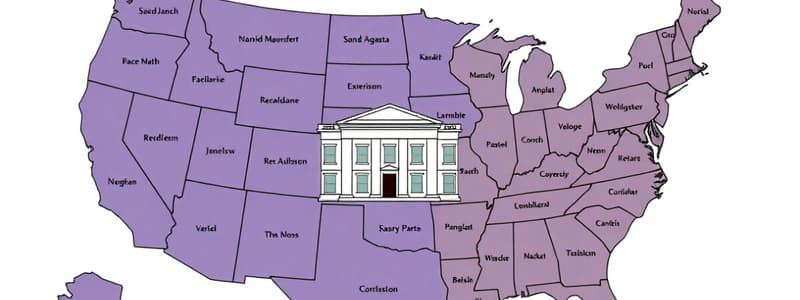Podcast
Questions and Answers
What is the main purpose of the Tenth Amendment?
What is the main purpose of the Tenth Amendment?
The Tenth Amendment aims to reserve powers not granted to the federal government to the states and the people.
How does the Tenth Amendment reflect the principle of federalism?
How does the Tenth Amendment reflect the principle of federalism?
It delineates the distribution of powers between the federal government and the states, asserting that states retain powers not specifically assigned to the federal level.
In what areas has the federal government expanded its power since the Tenth Amendment was ratified?
In what areas has the federal government expanded its power since the Tenth Amendment was ratified?
The federal government has expanded its power in areas such as healthcare, education, and environmental protection.
What two groups emerged during the debates over the ratification of the Constitution, and what were their main positions?
What two groups emerged during the debates over the ratification of the Constitution, and what were their main positions?
What actions can states take in response to federal laws they challenge?
What actions can states take in response to federal laws they challenge?
Why is the tension between federal and state rights a prominent issue in American politics today?
Why is the tension between federal and state rights a prominent issue in American politics today?
Why are the Articles of Confederation considered a failure in establishing a federal government?
Why are the Articles of Confederation considered a failure in establishing a federal government?
What was the purpose of James Madison's Federalist No. 10, and what solution did it propose?
What was the purpose of James Madison's Federalist No. 10, and what solution did it propose?
Describe the Great Compromise and its significance in the U.S. legislative system.
Describe the Great Compromise and its significance in the U.S. legislative system.
What were the Federalist's views on individual liberties and how did they address Anti-Federalist concerns?
What were the Federalist's views on individual liberties and how did they address Anti-Federalist concerns?
Flashcards
Federalism
Federalism
A system of government where power is divided between a national government and state governments.
Articles of Confederation
Articles of Confederation
The first attempt to establish a federal government in the United States, adopted in 1781. It gave most power to the states, leaving the national government weak.
Federalists
Federalists
Supporters of a strong national government with broad powers. They argued for a centralized government to create stability and protect individual liberties.
Anti-Federalists
Anti-Federalists
Signup and view all the flashcards
The Great Compromise
The Great Compromise
Signup and view all the flashcards
What does the 10th Amendment say?
What does the 10th Amendment say?
Signup and view all the flashcards
What is Federalism?
What is Federalism?
Signup and view all the flashcards
How does the 10th Amendment relate to Federalism?
How does the 10th Amendment relate to Federalism?
Signup and view all the flashcards
What is State Sovereignty?
What is State Sovereignty?
Signup and view all the flashcards
What is the ongoing debate about Federalism?
What is the ongoing debate about Federalism?
Signup and view all the flashcards
Study Notes
Federalism in the United States
- Federalism is a system of government where power is divided between a national government and state governments.
- It is a key principle of the US Constitution, stemming from the debates between Federalists and Anti-Federalists at the Constitutional Convention of 1787.
The Articles of Confederation
- The Articles of Confederation was the first attempt at a federal government in the US.
- Adopted in 1781, it vested significant power in the states, resulting in a weak national government.
- The Articles proved fundamentally flawed due to their inherent weaknesses.
The Constitutional Convention
- The Constitutional Convention of 1787, held in Philadelphia, addressed the shortcomings of the Articles of Confederation.
- Federalists championed a strong national government with broad powers.
- Anti-Federalists advocated for a weaker national government, prioritizing greater state autonomy.
Federalist Arguments
- Federalists championed a strong central government to foster better interstate relations and bolster individual liberties.
- They also believed a strong national government would safeguard the interests of economic minorities, like industrialists and elites.
- James Madison's Federalist No. 10 underscored the dangers of factions and argued that a large republic with a robust central government could mitigate their influence.
- Federalists championed the separation of powers, aiming to prevent any single branch from becoming overly powerful.
- To gain broader acceptance, Federalists ultimately agreed to a Bill of Rights.
Anti-Federalist Arguments
- Anti-federalists feared a powerful national government would infringe on individual and state liberties.
- They favored smaller, more localized governing structures.
- Anti-Federalists argued for a Bill of Rights to unequivocally protect individual rights and prevent potential tyranny from the national government.
The Great Compromise
- Roger Sherman proposed a compromise bridging the gap between Federalists and Anti-Federalists, resulting in a bicameral legislature (a two-house system).
- The House of Representatives’ representation is tied to population.
- The Senate grants equal representation to each state.
- The compromise also established checks and balances between the executive, legislative, and judicial branches of government.
The Tenth Amendment
- The Tenth Amendment states that powers not explicitly granted to the US government by the Constitution, nor withheld from the states, are reserved for the states or the people.
- It safeguards the principle of federalism by defining and protecting state powers from potential federal encroachment.
Federalism in the 21st Century
- The balance of power between the federal and state governments remains a point of contention.
- The federal government has expanded its influence in areas like healthcare, education, and environmental protection.
- States frequently challenge federal laws or assert their own authority through legislative and judicial processes.
- The tension between federal and state rights continues to be a significant facet of American politics.
Studying That Suits You
Use AI to generate personalized quizzes and flashcards to suit your learning preferences.




